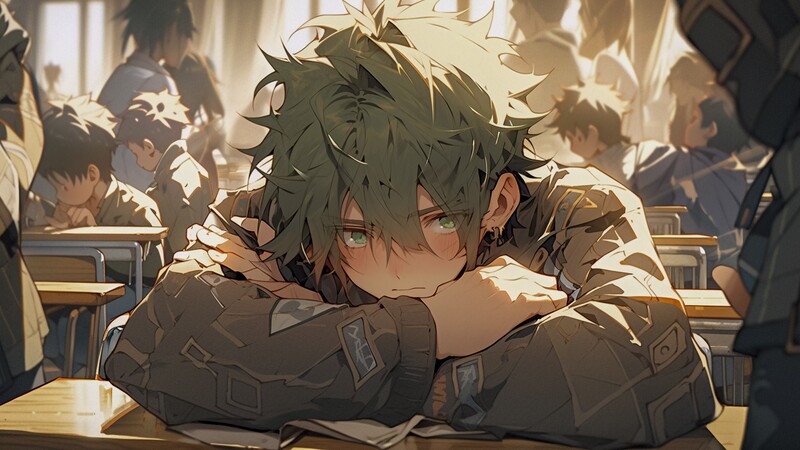Anime has surged in popularity, captivating audiences worldwide with its unique aesthetic and storytelling. This article delves into the defining features of the anime aesthetic, its historical evolution, and its impact on global culture.
What Defines the Anime Aesthetic?
Anime, a style of animation originating from Japan, boasts a distinctive aesthetic that sets it apart from other forms of animation. Several key elements characterize this aesthetic:
Visual Style
The visual style of anime is one of its most recognizable features. Characters typically have large, expressive eyes, exaggerated facial expressions, and a wide range of hair colors and styles. The backgrounds often feature intricate details, whether depicting urban landscapes or fantastical worlds.
Color Palette
Anime frequently employs vibrant color palettes, contributing to its unique visual appeal. The use of color can convey a wide range of emotions and atmospheres, from the bright and cheerful to the dark and mysterious.
Character Design
Character design is crucial in anime. Each character is meticulously crafted to reflect their personality, role, and the series’ overall theme. This design includes not just physical attributes but also clothing, accessories, and even the way they move and speak.
Storytelling Techniques
Anime storytelling often integrates elements of fantasy and science fiction, allowing for limitless creativity. Story arcs can range from episodic adventures to complex, multi-season sagas. Themes often explore deep philosophical questions, societal issues, and personal growth.
Historical Evolution of the Anime Aesthetic
The evolution of the anime aesthetic is deeply rooted in Japan’s cultural and historical context. Understanding this evolution provides insight into its current global influence.
Early Beginnings
The earliest forms of Japanese animation appeared in the early 20th century, heavily influenced by Western animation. However, Japanese animators quickly began developing their unique style. By the 1960s, with the emergence of influential works like Osamu Tezuka’s “Astro Boy,” anime began to establish its distinct aesthetic.
The Golden Age of Anime
The 1980s and 1990s are often referred to as the Golden Age of Anime. During this period, many iconic series and films were produced, including “Dragon Ball,” “Sailor Moon,” and Studio Ghibli’s masterpieces. The aesthetic during this era became more refined, with improved animation techniques and more complex storytelling.
Modern Anime
In the 21st century, anime has continued to evolve. Advances in technology have allowed for more sophisticated animation and special effects. Modern anime often blends traditional hand-drawn elements with digital animation, creating a seamless visual experience.
The Global Impact of Anime
Anime’s aesthetic and storytelling have had a profound impact beyond Japan, influencing global culture in various ways.
Influence on Fashion and Art
Anime has significantly influenced fashion and art. The vibrant colors, unique clothing styles, and overall visual appeal of anime characters inspire designers and artists worldwide. Cosplay, where fans dress up as their favorite anime characters, has become a global phenomenon, showcasing the deep cultural impact of anime.
Cultural Exchange
Anime serves as a medium for cultural exchange, introducing global audiences to aspects of Japanese culture, language, and traditions. It has fostered a greater appreciation and understanding of Japan’s cultural heritage.
Entertainment Industry
The influence of anime extends to the broader entertainment industry. Many Western animated series, films, and even video games draw inspiration from anime’s aesthetic and storytelling techniques. This cross-pollination has led to a richer, more diverse entertainment landscape.
Online Communities and Fandoms
The rise of the internet has facilitated the growth of global anime communities and fandoms. Online platforms allow fans to connect, share content, and discuss their favorite series. This sense of community enhances the overall anime-watching experience, making it a more interactive and engaging activity.
Why Anime Resonates with Global Audiences
Several factors contribute to the global appeal of anime, making it a beloved form of entertainment for millions.
Relatable Themes and Characters
Anime often explores universal themes such as love, friendship, and perseverance. The characters, despite their fantastical settings, face challenges and experiences that resonate with audiences on a personal level.
Diverse Genres
The diversity of genres within anime ensures there is something for everyone. Whether you enjoy action, romance, horror, science fiction, or slice-of-life stories, anime has a series or film that caters to your preferences.
Emotional Depth
Anime is known for its emotional depth. The storytelling often evokes strong emotions, whether it’s joy, sadness, excitement, or nostalgia. This emotional connection keeps viewers engaged and invested in the characters and their journeys.
High-Quality Production
Many anime studios prioritize high-quality production values. From meticulously detailed artwork to well-crafted soundtracks, the overall production quality enhances the viewing experience and draws audiences into the anime’s world.
Conclusion: The Ever-Growing Appeal of Anime
The aesthetic of anime, with its vibrant visuals, engaging storytelling, and cultural richness, continues to captivate audiences worldwide. As anime evolves and integrates new technologies and storytelling techniques, its influence on global culture will likely grow even more profound. Whether you are a long-time fan or new to the world of anime, its unique aesthetic and compelling narratives offer an unparalleled viewing experience that transcends cultural boundaries.
